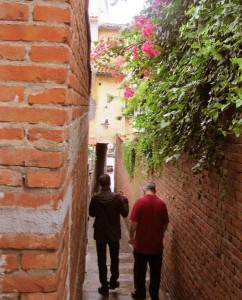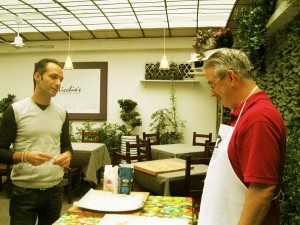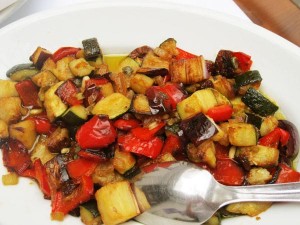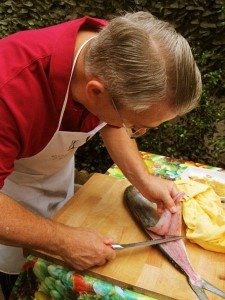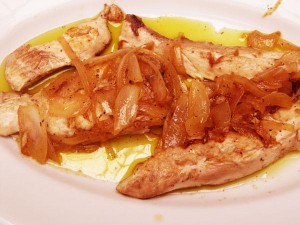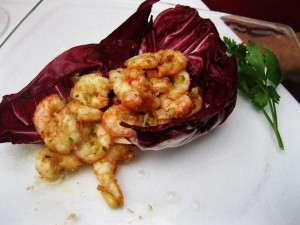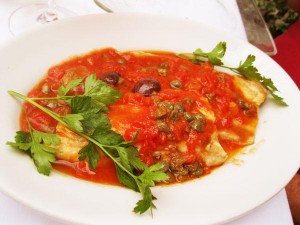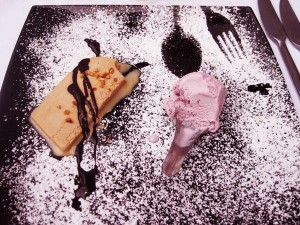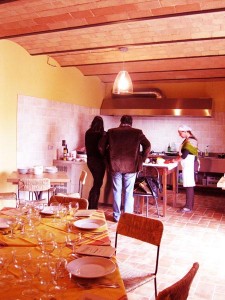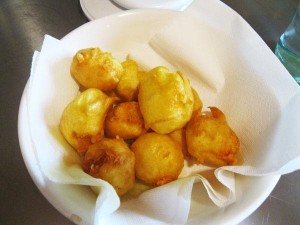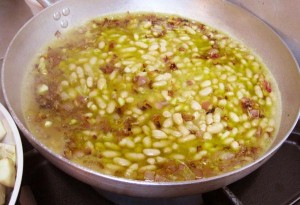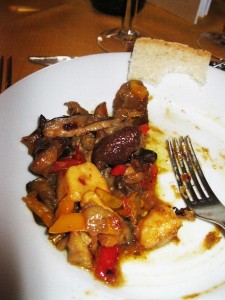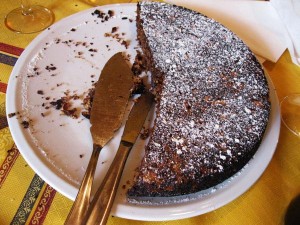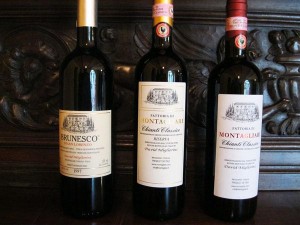By Jay Martini (jnm123)
For my 30th wedding anniversary, I wanted to prove that there was more to the planet than New York City or Las Vegas. I wanted to bust preconceptions and welcome the unexpected.
So my wife and I did Italy – or, more specifically, as much of Italy as one can do in eight days. For years, I had been regaled with stories from friends and business colleagues about the history, the paintings, the cathedrals, the sculptures, but mostly the food. The food! My goodness, the way they went on about what they consumed over there, I enviously began to think that some new series of tastes and flavors had been discovered. And while I thought I was a pretty decent cook of all things Italian, I had always wondered what was lost in the translation from there to here. So, we wanted the focus of the trip to be a couple of cooking classes.
After exploring websites and finding guided culinary adventures online, my wife and I eventually decided – with a certain amount of trepidation – to go it alone. We chose, for our first class, the exotic semi-tropical island of Sicily. And then we chose a second class in Chianti, the better to experience diverse regional cooking within the same country.
Culinary Traditions of Sicily
According to research we did before we left, Sicily has had a fascinating history of rulers: 735 B.C. – Greeks; 264 B.C. – Romans; 410 A.D. – Vandals (Germany); 535 – Greeks; 827 – North Africans; 1061 – Arab Normans; 1194 – Germanics; 1266 – French; 1282 – Spain; 1734 – Spain (Bourbons); 1861 – Italy; 1940 – Germany; 1943 – Italy. I suspected this revolving-door characteristic would be a good indicator of interesting cuisine.
And we found out that our beautiful hotel, the Hotel Villa Schuler on the mountainside overlooking the Ionian Sea, was an outpost controlled by the German army during World War II. In that vein, we observed many tourists reading menus in German and ordering Sicilian versions of sweet/sour meatballs with red onions at the trattorias along Corso Umberto, the main drag in Taormina – and quite possibly the only flat street in town. It seemed that everything else was either up or down the mountain; stairs are numerous and mountain goats would feel right at home.
The Marketplace Experience
Well in advance, we had enrolled in a private cooking class with Angelo Longo, owner/chef of Ristorante Licchio’s in Taormina. We’d gotten the heads-up about him online, and confirmed our plans via email. Angelo himself responded, asking for no credit card but assuring us, “Yes, I will be there, on October 11, 0900 hours, and it will cost 160 Euro.”
Despite our misgivings about such an informal confirmation, Chef Angelo was at Licchio’s as promised. We exchanged pleasantries and started our day with a short walk to the tiny Mercato Comunale to buy ingredients for the day and to get a feel for a small-town market, which in Taormina pretty much supplants the grocery store.
As we were descending the long stone staircase towards the market with the morning sea air in our faces, Angelo told us we were shopping for the locally-grown (or caught) components of our meal, mostly fish and vegetables that had to be bought today from the vendors. And I soon realized that this was to be a common thread throughout the day. “Local is best,” Angelo told us more than once.
Walking into the quasi-dingy market, at once we heard what appeared to be catcalls from the man standing behind the bins of fish, who was staring at us with a fierce smile. His words sounded fairly angry but had a sing-song cadence that was almost operatic in nature. Angelo responded with needling retorts, which led us to determine that Angelo and the fishmonger had acted out this particular comedic drill many times before. Both of them were speaking in Sicilian, which is not a dialect but an ancient language all its own, derived mostly from Latin, with Greek, Arabic, and Catalan influences. Sadly, the fishmonger’s generation is probably the last to speak it fluently, as primary grades in Sicily all teach Italian now.
Cooking Sicilian Style
Once we had obtained our foodstuffs, we returned to Licchio’s and the real magic began. Even though Angelo is a good twenty years younger than me, he struck me as very professorial in his demeanor, calmly directing what went where in the setup while my wife observed and took pictures. He spoke perfect English, albeit slightly accented. I think my wife could’ve listened to him speak for hours on end.
The upcoming menu consisted of caponata, tuna two different ways, stuffed zucchini blossoms, baked shrimp with native pistachios, and homemade “umbrella” pasta with Sicilian sauce. The prep work was done for us, so our lesson consisted mainly of actually putting the ingredients together and cooking them.
This vibrant caponata was painstakingly sautéed one vegetable type at a time in olive oil, meaning separate pans for the onion, eggplant, zucchini, and red pepper. The vegetables were then combined with pine nuts and raisins. Angelo informed us that the reason for this was that each item cooks at a different rate, and each requires a specific degree of doneness.
As part of my duties for the day, I helped filet a small tuna that had been caught early that same morning, which we had purchased only an hour before at the market. This was a learning experience for me, as I had never gutted a fish before. I’m surprised I didn’t cut my fingers off with the extremely sharp knife, since the tuna scales were sharp and ultra-slippery. Angelo instructed me to firmly hold the fish crosswise with a towel before I made the initial lengthwise cut down the back.
Adding to the tenseness of the moment, it was precisely at this time that the skies opened over Taormina and torrents of a steamy Mediterranean rain blasted us from above. The cooking area, which normally serves as the garden dining area of Licchio’s, was covered only by a large canvas sail, and it was beginning to leak around the perimeter. Angelo and I looked at each other for a moment, then he nodded for me to keep going. Fortunately, the storm subsided after a few minutes, but the weather certainly increased the pressure I felt to do well.
My debut attempt at filleting didn’t exactly render spectacular results, at least aesthetically. But this sweet and sour tuna with white onions, tonno all’Agrodolce, tasted fabulous. In this dish, the key turned out to be sautéing and caramelizing the onions to a golden-brown before placing the tuna fillets in between for a quick sear. “Agro” means bitter or sharp, while “dolce” means sweet – two concepts combining into a perfect example of the yin-yang engine that revs up so much of Sicilian cooking.
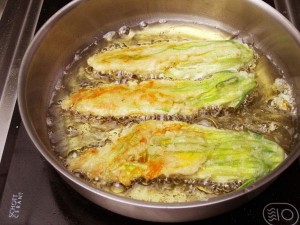
We also made zucchini blossoms stuffed with sweet ricotta, dipped in flour and egg and pan-fried in vegetable oil. Preparation for these beauties was relatively simple. The “frosting bag,” as I called it, held a mix of ricotta, salt, sugar, and a little parsley. It was carefully squeezed into the delicate blossoms. A liberal amount of canola oil was heated to a medium bubble; the dipped and stuffed blossoms were cautiously placed in the oil. We made sure to leave plenty of room in the pan, as Angelo warned against overcrowding them. The result was crunchy and soft. I have yet to enjoy a comparable rendition in the U.S.
My inexperience got in the way of creating a picture-perfect pasta dish, complete with flash-fried eggplant in tomatoes. The pasta pieces were supposed to be long, with a hole created by wrapping dough around a (hopefully) clean umbrella spoke. But I just knew the pasta would get bollixed up, even if I seemingly did all the right things – creating a mountain of semolina flour, cracking two eggs onto the top, working the dough with the flat of my hand, and then forming cylinders around the spokes. The process was delightfully archaic, but easier said than done; stretch the dough too thinly on the spoke and you make a hole. Despite the odd shapes that resulted, the eggplant helped disguise my amateurism and this dish was quite good.
The decision to stir bread crumbs and chopped Mount Etna pistachios in with freshly-caught shrimp from the Ionian Sea, then baking it all and serving the whole shebang on a bed of radicchio, was a revelation. Angelo told us that these pistachios, from the tiny hill town of Bronte on the slopes of Etna, had a unique flavor due to the climate and location of the trees. Indeed, Bronte is the pistachio capital of Sicily (no pistachios are grown in mainland Italy) and its pistachio is highly regarded throughout Europe and Asia for its intense green color and full taste.
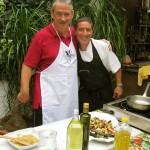
It should be mentioned here that I was heavily involved in cooking all these dishes, with instruction from Angelo and aided by an extra set of hands from his erstwhile assistant Nino. Nino proved an invaluable aide as quite often we had three or four pans going at the same time, so Angelo would be manning one sautéing operation while directing Nino to help me out or start something else. Our operation seemed constantly on the verge of chaos – but we never quite stepped over the line, a testament to the skill of our hosts.
We finished our meal with a hazelnut and blueberry gelato, although Angelo called it fragola, the literal translation of which is “strawberry.” A damn nice conclusion, alongside a bottle of red and a bottle of white wine. At noon.
As my wife and I were savoring our fragola with a last bit of wine, Angelo sat down at our table. Our personalized cooking class had turned out to be everything as advertised and more, and as we told him this, he looked at us and said, “More than anything else, I really want you to understand the passion we have for our food here in Sicily. Our ingredients are the best because we make them the best. For the shrimp, it works only with the pistachios from Bronte. Then we take our time, as you can see with how we prepare the caponata.”
Here’s what I learned on this day: Sicilian cooking is exactly all the things I had hoped for – an intoxicating mix of all the countries that informed its history, infused with the spirit of the cultures and the people that made the island their home at some point. The pine nuts, raisins and citrus present in Chef Angelo’s dishes were part of an Arabic influence that pervades Sicilian cooking, while fish, olives and pistachios speak to a partially Greek heritage – they were the first recorded colonists at Giardini Naxos, the next cliff over from Taormina on the eastern coast. The German influence was also present – the distinct aroma of onions, red wine vinegar and sugar together are reminiscent of sauerbraten (I’m thinking specifically of the version at the old Heidelberger Fass restaurant on Chicago’s north side).
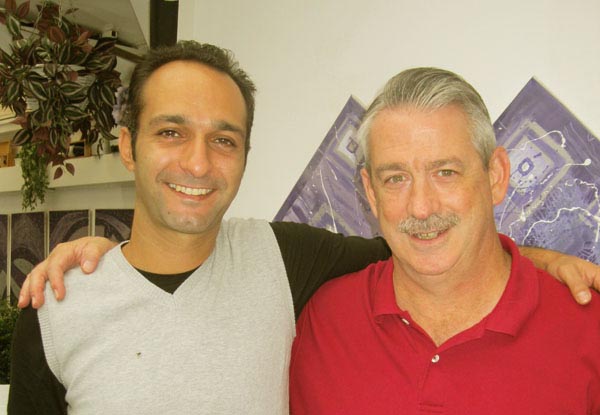
Chianti – Into the Tuscan Countryside
Such an incredible experience in Sicily, a true bonding of culture and food, only whetted our appetite for our second cooking lesson, about 15 k.m. south of Florence at the Montagliari Winery in Chianti wine country, part of the Tuscany region in Italy. This time, we depended on recommendations from friends to find Eugenio Martinez, the Tuscany guide who shepherded us and who has proved determined to show visitors the wondrous seasonal variations of Tuscan cuisine.
Martinez runs cooking classes together with Chef Antonio Alfani. These classes generally take place in the country kitchen of Martinez’s own home, a converted 10th-century church near San Casciano in Val di Pesa. However, our lesson on this day took place in an open kitchen at the Montagliari Winery, located in Panzano-in-Chianti. He picked up my wife and me at the appointed spot, a street along the Arno River, and off we drove into the Tuscan countryside. On the way, as we cruised in his little sedan through the rolling hills of Chianti, Eugenio explained what he tries to accomplish through his tour company, Ars Opulenta: exposing visitors to Tuscany to the art, the history, the architecture – and tying it all together, the food.
He explained to us how the cooking lesson menus change with the weather. Ours would include late summer/early fall courses that accented the ending of the fresh vegetable season and coupled them with more typically warming dishes to take the chill off as thermometer readings drop. I could see instantly that this encounter was going to be far different than our Sicily experience. Here, in northern Italy, we would indulge in a predominantly Roman and Germanic tradition versed in simplicity and heavy in ingredients such as tomatoes, bell peppers and mushrooms.
Tuscan or Florentine cuisine has been described as “rustic” and “a carnivore’s delight,” no doubt because of numerous cured meats like the prosciutto and finocchinoa slabs hanging at the markets, and the fabled bistecca alla Florentine served at many of the finest trattorias in Florence. This dish consists of a massive, marbled T-bone steak seared on both sides, seasoned only with salt and pepper – a preparation that dates from the Medici days in the 16th century. We also noticed at our leisurely dinners around Florence that the chefs had quite an affinity for local bitter greens like arugula in conjunction with sharp Pecorino cheese, homemade Tuscan bread loaves and legumes – including an abundant usage of dry beans.
The Kitchen at Montagliari

We arrived at the Montagliari estate, walking through the arched doorway of the stone-hewn building into a large kitchen. Antonio, a chef who has cooked in New York, Paris and Rome, proved to be a genial sort. He got us to work almost immediately, after pouring house rose wine for all of us as an aperitif. This included chopping and dicing red and yellow peppers, dredging and coating the chicken breasts, and hydrating the dried porcini mushrooms.
Fortunately, these were all tasks within my skillset. I grooved on being able to slice onions and celery while sipping the chilled rose and listening to conversation, interjecting an occasional comment. There was an unruffled, easygoing vibe present that was as comforting as the October breeze in Chianti, poking at the endorphins in my brain just as deftly as the controlled chaos in Sicily did.
From a cooking standpoint, the main tactile difference between this class and the one in Taormina was that here, we all contributed to preparation but Chef Alfani handled most of the final stages in each dish before plating. We did the prep work. And although my wife and I both did some stirring and sautéing, it was always under Antonio’s watchful eye. In Sicily, we succeeded or went down in flames with the actual cooking; but on this day, stepping back, observing and then consuming was more than satisfying to us.
A Northern Italian-Inspired Dinner
Our meal began with New Orleans-style beignets, flash-fried with a dollop of domestic cheese instead. These acted as great appetizers with which to start our meal.
We continued with an authentic but simple pasta e fagioli – mixed pasta and cooked beans in an oniony broth, but served with no juice whatsoever. I cannot tell you how satisfying this was. It was perfectly executed peasant food – mild, filling, with each bean and noodle independent of one another and not mushy in the least. I immediately pictured myself on a football Sunday dishing up bowls of this wonderful stuff to family and friends.
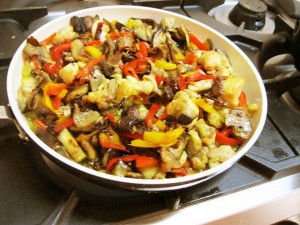
We also created a hunter-style chicken cacciatore that was redolent of the in-season porcini mushrooms, although these had been dried and re-hydrated before cooking. Even so, the consistency was unmatched, the roux-like gravy just right. Almost Szechuan-tasting.
For dessert, we devoured a sinful flourless chocolate cake, which oddly went very well with the Chianti Classico. And speaking of wines (we were in a winery after all), our meal was accompanied by a Montagliari lineup that had me brain-fogged after a while, but in a good way. These were perfect counterpoints, all of these super Tuscan wines, especially the ’97 Brunesco. As part of our experience, we even took a tour of the estate with vintner David Migliorini – but that’s a tale for another day.
Reflections
The lesson plan, as outlined by Eugenio Martinez, was all about making acquaintances, creating new life experiences, and enjoying laughs. After our repast, we sat for a couple of hours in a delightful dining room with our guide, our chef, and a friend named Nathalie, from Stockholm, letting time ebb away slowly as that glorious fall breeze wafted in through the open door that looked out to the countryside. Conversation ranged from Nathalie’s upbringing in Sweden to the persistent rumor that the estate out the window and a couple fields over was once home to the woman who was Leonardo Da Vinci’s model for the Mona Lisa. It was that type of aimless dialogue that strangers-turned-new-friends have, a blank canvas of interaction to be filled.
I truly enjoyed my time in Chianti, and wished that impending work, family, life in general wouldn’t have to eventually infringe upon the nirvana-like mellowness. And I also relished the hands-on experience of the intense cooking session in Sicily, where the local ingredients played such a huge part of the encounter in general, so much so that I could sense the passion in Angelo Longo’s bones.
What really floored me, however, was how our first impression of total havoc in Florence – from the traffic around Peretola airport to the tumult of crowds of people shopping for jewelry at the Ponte Vecchio – ended up being totally misleading. It took me almost four days to realize it, and it required the sublime cooking and dining experience at Montagliari on that lazy afternoon for the light bulb in my head to illuminate. But I realized that to talk, to converse with the person adjacent to your table, while savoring a roll and an espresso in the morning at a cafe or a relaxed four-course dinner late into the evening at a ristorante next to the Arno, was the thing. The movement from one course to the next – antipasto, primo, secondi, dolce – might in the U.S. simply be classified as separate presentations of appetizer, soup, entrée & dessert, but in these parts, in the home of the Renaissance, it’s a four-act play. And we loved every bit of it – even our lesson about stashing the smartphone and looking across the table instead.
As for this anniversary trip, with so much unknown at the outset, it was a great success overall. I suspect my wife will stick with me for the next 30 years if I keep exposing her to food like this, and to culinary experiences that will last a lifetime.



